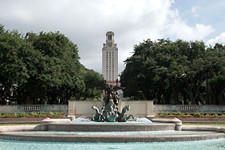Naked City
Stakeholders debate new Edwards water plan
By Kimberly Reeves, Fri., April 22, 2005

Protecting water quality is either a necessary cost of development or an obstacle standing in the way of reasonable land use, depending on which side of the debate you stand on. Austin voters passed the SOS ordinance 10 years ago. Today, it's still unclear what the price of that ordinance has been in terms of lost development, a point that is clearly most important to those who own and develop land in the protected water quality zones. The question of cost becomes a key one because stakeholders are debating a new regional water plan over the Barton Springs segment of the Edwards Aquifer and its contributing zone, a plan that does not have a full price tag yet, either to developers or participating cities.
Engineer Hank Smith, at a hearing on the plan in Driftwood last week, told a group of mostly plan supporters that the cost of the regional water plan was high. In one illustration offered by the group, a developer was required to buy 16 acres elsewhere in the contributing zone in order to build a 4-acre parcel in the protected area. "If I want to build a small business on 4 acres to put a 7,500-square-foot office building on it, then I have to purchase 16 acres somewhere else," Smith said. "It's very stringent. People talk about SOS but this is more stringent than SOS, it has increased costs over SOS. SOS has been in place for eight or nine years. Do you know how many commercial development projects have complied with SOS in that time? Only three."
The SOS Alliance says Smith is only counting the three major commercial projects. Executive Director Bill Bunch says far more residential and small commercial projects are in compliance with the ordinance, along with the HEB on Brodie Lane, Temple Inland, Austin Waldorf School, Clint Small Middle School, and a variety of residential projects. Colin Clark, spokesman for the SOS Alliance, says the numbers give a false picture for another reason as well. "The reason so few commercial projects have been built under the SOS ordinance is that so many have been 'grandfathered' by the city and state out of compliance with the ordinance, not because the ordinance is 'too strict,'" Clark says. "The regional plan allows for increased impervious cover in 'Preferred Growth Areas.' While we probably do not agree with that tactic, the point was to allow for commercial development in downtown Dripping Springs."
Clark says the plan, if anything, is too lenient for allowing such growth. History has shown it's impossible to urbanize a watershed and still have clean water, he said.
Got something to say on the subject? Send a letter to the editor.








